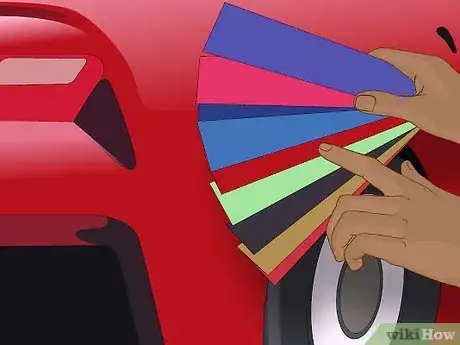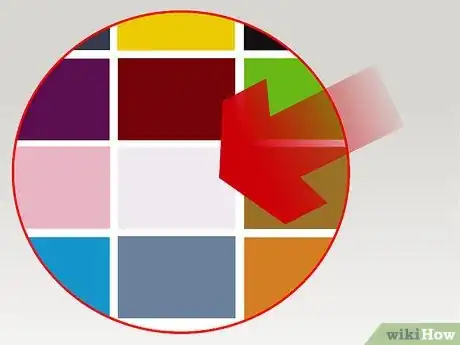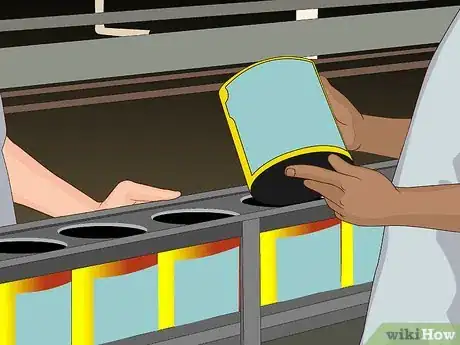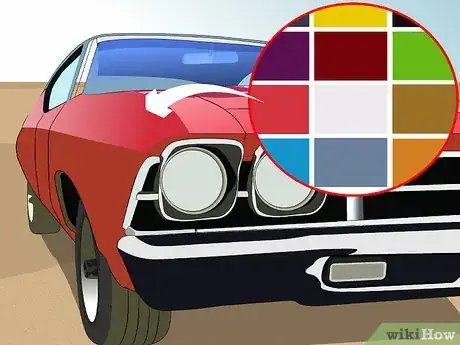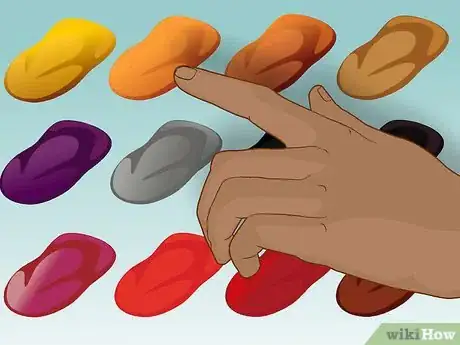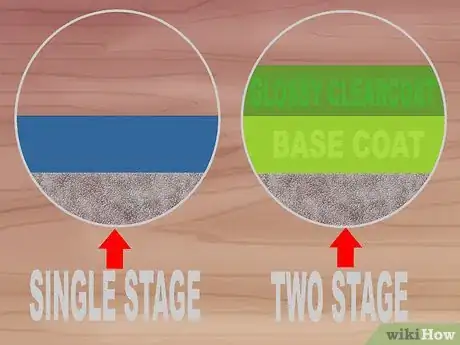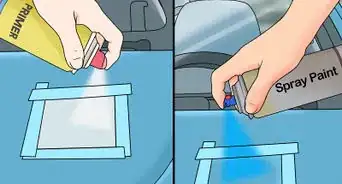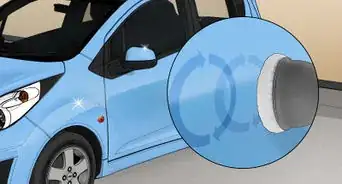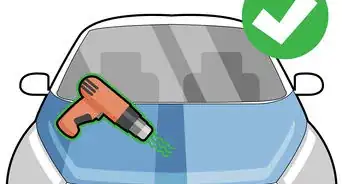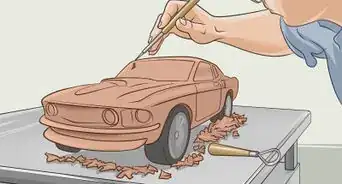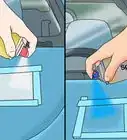This article was co-authored by wikiHow Staff. Our trained team of editors and researchers validate articles for accuracy and comprehensiveness. wikiHow's Content Management Team carefully monitors the work from our editorial staff to ensure that each article is backed by trusted research and meets our high quality standards.
This article has been viewed 99,515 times.
Learn more...
Whether you're choosing the color of your next car or thinking of repainting your current vehicle, there are many factors that can, and should, influence your decision. Ideally, the color of your car should not only reflect your personality, but also increase your visibility on the road and even hide dust and dirt. Instead of choosing a color on the spur of the moment, or based on what's available on the lot, select a color that fits your needs and taste.
Steps
Choosing the Right Paint Color on Your New Car
-
1Make a list of your favorite colors. Be sure that you are thinking about what colors you like on cars and not on other things, like walls. Also, let the creative juices flow for now. There will be factors that narrow your choices, but a common insurance myth scares many car buyers. Rest assured, it is not true that insurance rates change at all based on a car’s color.[1] [2]
-
2Select a car make and model. The make and model of your car can greatly influence your choice of color. Many people wouldn’t choose the same color for a minivan as they would for a sports car. Mark any colors off of your list that you think wouldn’t suit the car you want to buy.Advertisement
-
3Ask your dealer about color options for the make and model you want. Each make and model is available only in a certain variety of colors. Your dealer can tell you what color options they have for particular car. You can also do this research on your own ahead of time, but keep in mind that dealers typically keep neutral, safe colors.
- It is possible to special order a car. If you have the patience to wait for your car, you can order it in colors that the dealer does not have available.[3]
-
4Choose a color that will look good for the life of your car. You want to make sure that the car you buy today is something you still want to drive a few years from now. Some colors come in style for a short period, and then they fade away. If you are driving one of these fad colors after it goes out of style, your car might be showing its age (and yours). Choose a color that will endure the test of time.
-
5Choose white or silver for a safe color. Not only does your paint color affect how your car is perceived by other drivers, it also affects how your car is seen by other drivers. Having an easily visible car can possibly add an extra layer of safety to your driving experience. Drivers of silver cars are as much as 50% less likely to be harmed in an accident.[4] Some colors also hide dirt better than others and boast a higher resale value than other colors (silver in particular does both).
- It is worth noting that white cars are also found to be in fewer accidents than other colors.[5]
Picking a Color to Paint Your Car
-
1Match custom paint jobs to your car. It is quite expensive to paint a whole car, and usually not worth it for an everyday driver. Most whole body paint jobs are the result of some kind of special customization or restore. With this in mind, you want to know a little bit about the car you intend to paint and make sure that you choose a color scheme that suits your car. often this means sticking with a vintage color ― something that might have been on the car when it was new. Other times, it means a color scheme that brings out the best features of the car, even if that color scheme was never an original from the manufacturer.
- An example of a paint job that isn’t likely to flow would be restoring a ‘69 Chevelle, having a supercharger sticking up out of the hood, and painting it pink with purple polka dots.
-
2Use your imagination. The great thing about restoring or customizing a car is the opportunity to truly have whatever you want. The end result should be something you are proud of, so naturally it has to be something that you like. Envision exactly what you want your car to look like.
-
3Consult a professional painter about your paint job. Whether you know what you want or not, an open dialogue with the painter is never a bad idea. They can help steer you toward the paints that will give you the look your heart desires. A professional artist/painter can also help to expand on your ideas if you get stuck at any point.
Understanding Paint Color Options for Yourself
-
1Know where to get the color you want. Paint basically falls into two very large categories. Factory paint is paint that comes standard on a particular model from the manufacturer. Custom paint is also just what it sounds like ― paint tailored specifically to your taste that is not available from the manufacturer.[6]
-
2Know what look you want. Three common paint options are solid colors, metallic colors, and pearl colors. Each has its advantages and disadvantages. For example, solid colors can be cheaper and easier to apply evenly, but often look more plain. Metallic colors can be a bit more exciting, as they satisfy our lust for shiny things in a society fixated on technology, but light metallic colors can be quite difficult to apply. Pearls give a depth of color that solids nor metallics can match, but do not hide inconsistencies in the color very well.[7]
-
3Consider less common paint options. Two options that are seen on custom vehicles, but rarely on factory cars are candy color and chameleon paint. This is partly because candy colors are less durable than more common paints, and chameleon paints are quite difficult to apply evenly. That being said, candy colors are known for their superior depth of color (even compared to peal), and chameleon paints stand out in any crowd since the color changes depending on the viewer’s vantage point.[8]
-
4Understand the pros and cons of different layering techniques. You not only have the choice of what color to paint your car, you also get to choose what kind of paint to use. Single stage paints can be less expensive (you need less layers and less application time) and might be a good fit for solid colors. Two stage, or basecoat-clearcoat, paint applies the pigment (color) in the initial basecoat and then a glossy clearcoat is applied on top. This provides a great look and improved durability. Basecoat-clearcoat is almost always the best choice for metallic or pearl colors.
- Some pearls and metallics are actually applied as three-stage paints. The basecoat is applied first, and then the pearl or metallic finish is applied, and finally the clearcoat goes on last.[9]
Community Q&A
-
QuestionCan you please direct me to the most popular auto paint statistics?
 Community AnswerThe three most popular car colors, from most to least popular, are silver, white, and black. If you'd like to see more statistics, including colors broken down by type of car (sedan, SUV, etc.), you can check the Kelly Blue Book's information on car color statistics.
Community AnswerThe three most popular car colors, from most to least popular, are silver, white, and black. If you'd like to see more statistics, including colors broken down by type of car (sedan, SUV, etc.), you can check the Kelly Blue Book's information on car color statistics.
Warnings
- If you are planning to paint your own car, be sure you have all of the proper tools and knowledge to do so. Otherwise, it can be dangerous for you and the paint job.⧼thumbs_response⧽
- Painting a car is quite expensive. If you plan to do this (even on your own) know what you are getting into ahead of time.⧼thumbs_response⧽
References
- ↑ http://www.cars.com/go/advice/Story.jsp?section=ins&story=insurance-myths&subject=cover&refer
- ↑ https://www.esurance.com/info/car/myth-red-cars-cost-more-to-insure
- ↑ http://www.autotrader.com/car-tips/buying-a-new-car-can-you-special-order-a-car-222548
- ↑ http://www.buyingadvice.com/popular-car-colors.html
- ↑ https://www.esurance.com/info/car/myth-red-cars-cost-more-to-insure
- ↑ http://www.thecoatingstore.com/car-paint-colors/
- ↑ http://www.thecoatingstore.com/car-paint-colors/
- ↑ http://www.thecoatingstore.com/car-paint-colors/
- ↑ http://www.thecoatingstore.com/car-paint-colors/

